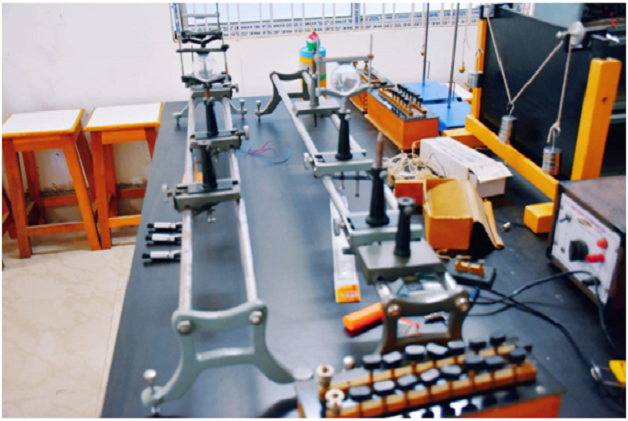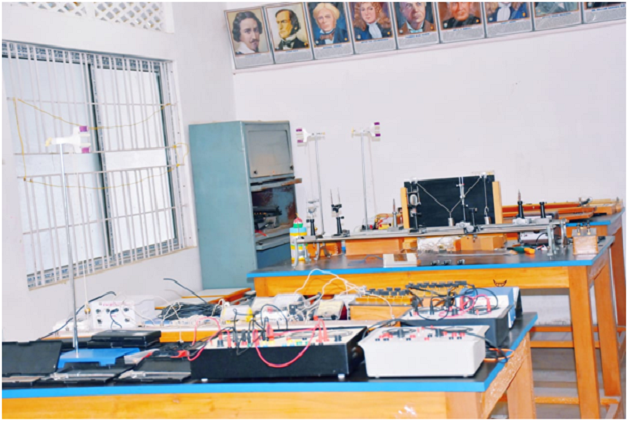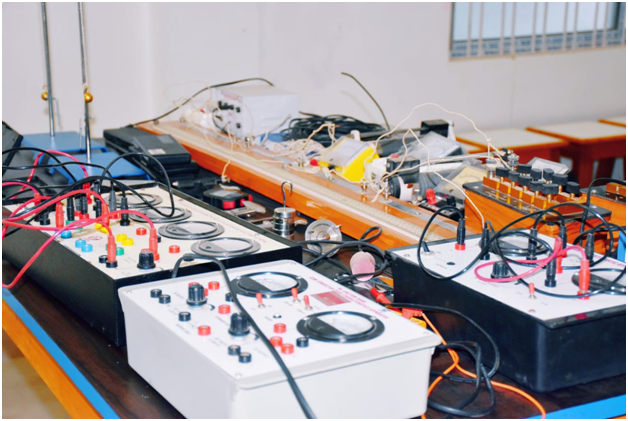| PRACTICALS AND ACTIVITIES FOR CLASS – XI | |
|---|---|
| Max. Marks : 30 | Time : 3 Hours |
| Evaluation Scheme | |
| Two experiments one from each section | 7+7 Marks |
| Practical record (experiment and activities) | 5 Marks |
| One activity from any section | 3 Marks |
| Investigatory Project | 3 Marks |
| Viva on experiments, activities and project | 5 Marks |
| TOTAL | 30 Marks |
PRACTICALS AND ACTIVITIES SYLLABUS : 60 Periods
The record, to be submitted by the students, at the time of their annual examination, has to include:- Record of at least 12 Experiments [with 6 from each section], to be performed by the students.
- Record of at least 6 Activities [with 3 each from section A and section B], to be performed by the students.
- Report of the project to be carried out by the students.
SECTION – A [ Experiment ]
- To measure diameter of a small spherical/cylindrical body and to measure internal diameter and depth of a given beaker/calorimeter using Vernier Callipers and hence find its volume.
- To measure diameter of a given wire and thickness of a given sheet using screw gauge.
- To determine volume of an irregular lamina using screw gauge.
- To determine radius of curvature of a given spherical surface by a spherometer.
- To determine the mass of two different objects using a beam balance.
- To find the weight of a given body using parallelogram law of vectors.
- Using a simple pendulum, plot its L-T2 graph and use it to find the effective length of second's pendulum.
- To study variation of time period of a simple pendulum of a given length by taking bobs of same size but different masses and interpret the result.
- To study the relationship between force of limiting friction and normal reaction and to find the co- efficient of friction between a block and a horizontal surface.
- To find the downward force, along an inclined plane, acting on a roller due to gravitational pull of the earth and study its relationship with the angle of inclination θ by plotting graph between force and sinθ.
ACTIVITIES
- To make a paper scale of given least count, e.g., 0.2cm, 0.5 cm.
- To determine mass of a given body using a metre scale by principle of moments.
- To plot a graph for a given set of data, with proper choice of scales and error bars.
- To measure the force of limiting friction for rolling of a roller on a horizontal plane.
- To study the variation in range of a projectile with angle of projection.
- To study the conservation of energy of a ball rolling down on an inclined plane (using a double inclined plane).
- To study dissipation of energy of a simple pendulum by plotting a graph between square of amplitude and time.
SECTION – B [ Experiment ]
- To determine Young's modulus of elasticity of the material of a given wire.
- To find the force constant of a helical spring by plotting a graph between load and extension.
- To study the variation in volume with pressure for a sample of air at constant temperature by plotting graphs between P and V, and between P and 1/V.
- To determine the surface tension of water by capillary rise method.
- To determine the coefficient of viscosity of a given viscous liquid by measuring terminal velocity of a given spherical body.
- To study the relationship between the temperature of a hot body and time by plotting a cooling curve.
- To determine specific heat capacity of a given solid by method of mixtures.
- To study the relation between frequency and length of a given wire under constant tension using sonometer.
- To study the relation between the length of a given wire and tension for constant frequency using sonometer.
- To find the speed of sound in air at room temperature using a resonance tube by two resonance positions.
ACTIVITIES
- To observe change of state and plot a cooling curve for molten wax.
- To observe and explain the effect of heating on a bi-metallic strip.
- To note the change in level of liquid in a container on heating and interpret the observations.
- To study the effect of detergent on surface tension of water by observing capillary rise.
- To study the factors affecting the rate of loss of heat of a liquid.
- To study the effect of load on depression of a suitably clamped metre scale loaded at (i) its end (ii) in the middle.
- To observe the decrease in pressure with increase in velocity of a fluid.
| PRACTICALS AND ACTIVITIES FOR CLASS – XII | |
|---|---|
| Max. Marks : 30 | Time : 3 Hours |
| Evaluation Scheme | |
| Two experiments one from each section | 7+7 Marks |
| Practical record (experiment and activities) | 5 Marks |
| One activity from any section | 3 Marks |
| Investigatory Project | 3 Marks |
| Viva on experiments, activities and project | 5 Marks |
| TOTAL | 30 Marks |
PRACTICALS AND ACTIVITIES SYLLABUS : 60 Periods
The record, to be submitted by the students, at the time of their annual examination, has to include:- Record of at least 12 Experiments [with 6 from each section], to be performed by the students.
- Record of at least 6 Activities [with 3 each from section A and section B], to be performed by the students.
- Report of the project to be carried out by the students.
SECTION – A [ Experiment ]
- To determine resistivity of two / three wires by plotting a graph for potential difference versus current.
- To find resistance of a given wire / standard resistor using metre bridge.
- To verify the laws of combination (series) of resistances using a metre bridge.
OR
To verify the laws of combination (parallel) of resistances using a metre bridge. - To compare the EMF of two given primary cells using potentiometer.
- To determine the internal resistance of given primary cell using potentiometer.
- To determine resistance of a galvanometer by half-deflection method and to find its figure of merit.
- To convert the given galvanometer (of known resistance and figure of merit) into a voltmeter of desired range and to verify the same.
OR
To convert the given galvanometer (of known resistance and figure of merit) into an ammeter of desired range and to verify the same. - To find the frequency of AC mains with a sonometer.
ACTIVITIES
- To measure the resistance and impedance of an inductor with or without iron core.
- To measure resistance, voltage (AC/DC), current (AC) and check continuity of a given circuit using multimeter.
- To assemble a household circuit comprising three bulbs, three (on/off) switches, a fuse and a power source.
- To assemble the components of a given electrical circuit.
- To study the variation in potential drop with length of a wire for a steady current.
- To draw the diagram of a given open circuit comprising at least a battery, resistor/rheostat, key, ammeter and voltmeter. Mark the components that are not connected in proper order and correct the circuit and also the circuit diagram.
SECTION – B [ Experiment ]
- To find the value of v for different values of u in case of a concave mirror and to find the focal length.
- To find the focal length of a convex mirror, using a convex lens.
- To find the focal length of a convex lens by plotting graphs between u and v or between 1/u and 1/v.
- To find the focal length of a concave lens, using a convex lens.
- To determine angle of minimum deviation for a given prism by plotting a graph between angle of incidence and angle of deviation.
- To determine refractive index of a glass slab using a travelling microscope.
- To find refractive index of a liquid by using convex lens and plane mirror.
- To draw the I-V characteristic curve for a p-n junction diode in forward bias and reverse bias.
- To draw the characteristic curve of a zener diode and to determine its reverse breaks down voltage.
ACTIVITIES
- To identify a diode, an LED, a resistor and a capacitor from a mixed collection of such items.
- Use of multimeter to see the unidirectional flow of current in case of a diode and an LED and check whether a given electronic component (e.g., diode) is in working order.
- To study effect of intensity of light (by varying distance of the source) on an LDR.
- To observe refraction and lateral deviation of a beam of light incident obliquely on a glass slab.
- To observe polarization of light using two Polaroids.
- To observe diffraction of light due to a thin slit.
- To study the nature and size of the image formed by a (i) convex lens, (ii) concave mirror, on a screen by using a candle and a screen (for different distances of the candle from the lens/mirror).
- To obtain a lens combination with the specified focal length by using two lenses from the given set of lenses.
SUGGESTED INVESTIGATORY PROJECTS
- To study various factors on which the internal resistance/EMF of a cell depends.
- To study the variations in current flowing in a circuit containing an LDR because of a variation in
(a) the power of the incandescent lamp, used to 'illuminate' the LDR (keeping all the lamps at a fixed distance).
(b) the distance of a incandescent lamp (of fixed power) used to 'illuminate' the LDR. - To find the refractive indices of (a) water (b) oil (transparent) using a plane mirror, an equi convex lens (made from a glass of known refractive index) and an adjustable object needle.
- To design an appropriate logic gate combination for a given truth table.
- To investigate the relation between the ratio of (i) output and input voltage and (ii) number of turns in the secondary coil and primary coil of a self-designed transformer.
- To investigate the dependence of the angle of deviation on the angle of incidence using a hollow prism filled one by one, with different transparent fluids.
- To estimate the charge induced on each one of the two identical styrofoam (or pith) balls suspended in a vertical plane by making use of Coulomb's law.
- To study the factor on which the self-inductance of a coil depends by observing the effect of this coil, when put in series with a resistor/(bulb) in a circuit fed up by an A.C. source of adjustable frequency.
- To study the earth's magnetic field using a tangent galvanometer.


